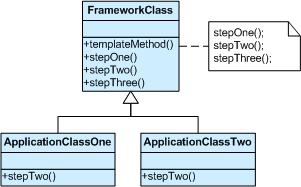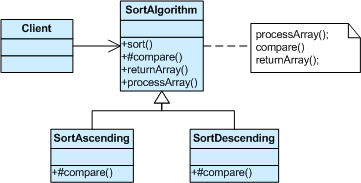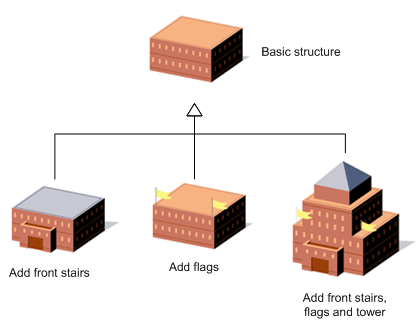Design Pattern----26.Behavioral.TemplateMethod.Pattern (Delphi Sample)
Intent
- Define the skeleton of an algorithm in an operation, deferring some steps to client subclasses. Template Method lets subclasses redefine certain steps of an algorithm without changing the algorithm’s structure.
- Base class declares algorithm ‘placeholders’, and derived classes implement the placeholders.
Problem
Two different components have significant similarities, but demonstrate no reuse of common interface or implementation. If a change common to both components becomes necessary, duplicate effort must be expended.
Discussion
The component designer decides which steps of an algorithm are invariant (or standard), and which are variant (or customizable). The invariant steps are implemented in an abstract base class, while the variant steps are either given a default implementation, or no implementation at all. The variant steps represent “hooks”, or “placeholders”, that can, or must, be supplied by the component’s client in a concrete derived class.
The component designer mandates the required steps of an algorithm, and the ordering of the steps, but allows the component client to extend or replace some number of these steps.
Template Method is used prominently in frameworks. Each framework implements the invariant pieces of a domain’s architecture, and defines “placeholders” for all necessary or interesting client customization options. In so doing, the framework becomes the “center of the universe”, and the client customizations are simply “the third rock from the sun”. This inverted control structure has been affectionately labelled “the Hollywood principle” - “don’t call us, we’ll call you”.
Structure

The implementation of template_method() is: call step_one(), call step_two(), and call step_three(). step_two() is a “hook” method – a placeholder. It is declared in the base class, and then defined in derived classes. Frameworks (large scale reuse infrastructures) use Template Method a lot. All reusable code is defined in the framework’s base classes, and then clients of the framework are free to define customizations by creating derived classes as needed.

Example
The Template Method defines a skeleton of an algorithm in an operation, and defers some steps to subclasses. Home builders use the Template Method when developing a new subdivision. A typical subdivision consists of a limited number of floor plans with different variations available for each. Within a floor plan, the foundation, framing, plumbing, and wiring will be identical for each house. Variation is introduced in the later stages of construction to produce a wider variety of models.

Check list
- Examine the algorithm, and decide which steps are standard and which steps are peculiar to each of the current classes.
- Define a new abstract base class to host the “don’t call us, we’ll call you” framework.
- Move the shell of the algorithm (now called the “template method”) and the definition of all standard steps to the new base class.
- Define a placeholder or “hook” method in the base class for each step that requires many different implementations. This method can host a default implementation – or – it can be defined as abstract (Java) or pure virtual (C++).
- Invoke the hook method(s) from the template method.
- Each of the existing classes declares an “is-a” relationship to the new abstract base class.
- Remove from the existing classes all the implementation details that have been moved to the base class.
- The only details that will remain in the existing classes will be the implementation details peculiar to each derived class.
Rules of thumb
- Strategy is like Template Method except in its granularity.
- Template Method uses inheritance to vary part of an algorithm. Strategy uses delegation to vary the entire algorithm.
- Strategy modifies the logic of individual objects. Template Method modifies the logic of an entire class.
- Factory Method is a specialization of Template Method.
Template Method in Delphi
Applications in Delphi
Abstraction is implemented in Delphi by abstract virtual methods. Abstract methods differ from virtual methods by the base class not providing any implementation. The descendant class is completely responsible for implementing an abstract method. Calling an abstract method that has not been overridden will result in a runtime error.
A typical example of abstraction is the TGraphic class.
TGraphic is an abstract class used to implement TBitmap, TIcon and TMetafile. Other developers have frequently used TGraphic as the basis for other graphics objects such as PCX, GIF, JPG representations. TGraphic defines abstract methods such as Draw, LoadFromFile and SaveToFile which are then overridden in the concrete classes. Other objects that use TGraphic, such as a TCanvas only know about the abstract Draw method, yet are used with the concrete class at runtime.
Many classes that use complex algorithms are likely to benefit from abstraction using the template method approach. Typical examples include data compression, encryption and advanced graphics processing.
Implementation Example
To implement template methods you need an abstract class and concrete classes for each alternate implementation. Define a public interface to an algorithm in an abstract base class. In that public method, implement the steps of the algorithm in calls to protected abstract methods of the class. In concrete classes derived from the base class, override each step of the algorithm with a concrete implementation specific to that class.
This example shows some very simple alogrithm steps, but illustrates the principle of deferring implementation to a subclass.
1: unit Tpl_meth;2:3: interface4:5: type6:7: TAbstractTemplateClass = class(TObject)8: protected9: function Algorithm_StepA: Integer; virtual; abstract;10: function Algorithm_StepB: Integer; virtual; abstract;11: function Algorithm_StepC: Integer; virtual; abstract;12: public13: function Algorithm: Integer;14: end;15:16: TConcreteClassA = class(TAbstractTemplateClass)17: protected18: function Algorithm_StepA: Integer; override;19: function Algorithm_StepB: Integer; override;20: function Algorithm_StepC: Integer; override;21: end;22:23: TConcreteClassB = class(TAbstractTemplateClass)24: protected25: function Algorithm_StepA: Integer; override;26: function Algorithm_StepB: Integer; override;27: function Algorithm_StepC: Integer; override;28: end;29:30: ...31:




